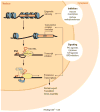Latency reversal and viral clearance to cure HIV-1
- PMID: 27463679
- PMCID: PMC5021637
- DOI: 10.1126/science.aaf6517
Latency reversal and viral clearance to cure HIV-1
Abstract
Research toward a cure for human immunodeficiency virus type 1 (HIV-1) infection has joined prevention and treatment efforts in the global public health agenda. A major approach to HIV eradication envisions antiretroviral suppression, paired with targeted therapies to enforce the expression of viral antigen from quiescent HIV-1 genomes, and immunotherapies to clear latent infection. These strategies are targeted to lead to viral eradication--a cure for AIDS. Paired testing of latency reversal and clearance strategies has begun, but additional obstacles to HIV eradication may emerge. Nevertheless, there is reason for optimism that advances in long-acting antiretroviral therapy and HIV prevention strategies will contribute to efforts in HIV cure research and that the implementation of these efforts will synergize to markedly blunt the effect of the HIV pandemic on society.
Copyright © 2016, American Association for the Advancement of Science.
Figures


References
-
- UNAIDS. Countries adopt UNAIDS Fast-Track Strategy to double number of people on life-saving HIV treatment by 2020. 2015 www.unaids.org/en/resources/presscentre/pressreleaseandstatementarchive/....
Publication types
MeSH terms
Substances
Grants and funding
LinkOut - more resources
Full Text Sources
Other Literature Sources
Medical

